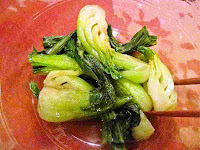20 calories (1/2 of recipe); 1.5 g protein; 0.2 g fat; 3.5 g carbohydrate; 2.3 g net carbs; 461 mg sodium (with 50% reduced-sodium soy sauce; 613 mg with regular soy sauce); 0 mg cholesterol; 1.2 g fiber
<Ingredients>
Pinch salt (to blanch chingensai; not in photo)
For karashi oyster sauce dressing
1 tsp oyster sauce
2 tsp soy sauce
1/2 tsp karashi mustard powder
1 tsp dashi
<Directions>
1.
Cut the bottoms of chingensai crisscross.
2.
Bring plenty of water to boil, and add salt.
Put chingensai, first immersing the bottom part, then leaves.
When white sections turn somewhat translucent (after 1 minute or so), remove from boiling water, and cool on zaru strainer.
3.
Meanwhile, mix all ingredients for karashi oyster sauce dressing.
Here, I first mix karashi and dashi, then add the karashi mixture to oyster sauce and soy sauce.
4.
When chingensai cools (to at least room temperature), squeeze out excess water, and split into quarters by hand.
Cut quarters crosswise into two.
5.
Immediately before serving, pour dressing over chingensai, and mix well.
<Notes>
- Cutting a crisscross pattern on the bottom of chingensai helps it to cook faster.
- This dressing is pretty strong. If chingensai is first separated into individual leaves and then blanched, add slightly more dashi to weaken the dressing.
- Alternatively, serve chingensai and dressing separately, and pour at the table.
(Last updated: August 17, 2014)














No comments:
Post a Comment